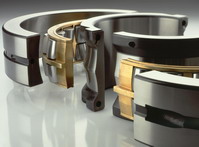 By replacing standard solid bearings with split cylindrical or spherical roller bearings, process manufacturers can reduce repair and overhaul costs on complex drive units for heavy machinery, including steel rolling mills and extruders.
By replacing standard solid bearings with split cylindrical or spherical roller bearings, process manufacturers can reduce repair and overhaul costs on complex drive units for heavy machinery, including steel rolling mills and extruders.
For process manufacturing companies, replacing worn or damaged bearings on drive units for heavy machinery is both time consuming and costly. Repair and overhaul of components soaks up valuable time and resources, often resulting in costly production downtime, while the equipment or machinery is offline being repaired. The harsh operating environment can also mean more regular maintenance being required on machinery.
In the steel industry, for example, split bearings can replace sliding bearings to support the heavy universal joint drive shafts on large rolling mills. For a typical rolling mill, the work rolls are driven by universal joint drive shafts. After every rolling cycle, the height of the rolls is adjusted. The drive shafts have to follow this adjusting movement and so are fitted with universal joints. Due to this height adjustment, the shaft length also varies, which must be compensated for in a coupling sleeve.
The universal joint shafts are usually very long to ensure that the deflection angles do not become too large. The shafts are also strong and heavy in order to withstand the high torque being transmitted. In larger rolling mills, the weight of universal joint shafts is supported by split single or double row cylindrical roller bearings in order to relieve the joints and couplings from this weight. Changes in the position of the universal joint shafts are compensated for in the housing suspensions. The split bearing design is required because the flanges that are forged to the universal joint shaft are much larger than the shaft diameter at the bearing seats.
Schaeffler’s FAG range of split cylindrical roller bearings are used for the locating and floating bearing positions and are of the single or double row design. The bearing outer rings, inner rings and rollers are made from case hardened steel, which makes the bearings less sensitive to vibration and axial shock loads. The inner rings, outer rings and cages are split and the split inner rings are located on the shaft by locking rings.
Other heavy industries are also benefiting from the use of split roller bearings. In the mineral processing, paper and petroleum sectors, for example, the drive units for heavy-duty extruder machinery are fitted with split spherical roller bearings to help reduce overhaul times and minimise production downtime.
Schaeffler’s FAG range of split spherical roller bearings with machined brass cages are mounted as locating and floating bearing units. With split spherical roller bearings, the inner ring, outer ring and cage assembly are split. A cylindrical bore provides direct mounting onto the shaft. These bearings typically offer high thrust load capability and dynamically compensate for any misalignment.
The outside diameter, outer ring width and shaft seat diameter are identical to the dimensions of the standard spherical roller bearings range. This means customers can easily replace solid bearings with split versions with an adapter sleeve. This means mating parts do not need to be removed during bearing replacement and adapter sleeves are no longer required, reducing replacement times considerably.
The FAG range includes both glass fibre reinforced polyamide or brass cages, and for special applications, split bearings with separate clamping rings can be supplied.
For more information on Schaeffler’s split cylindrical and spherical roller bearings, please visit www.schaeffler.co.uk or telephone the marketing department on 0121 351 3833.

